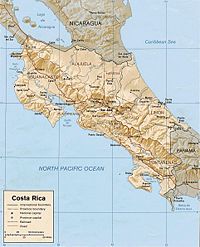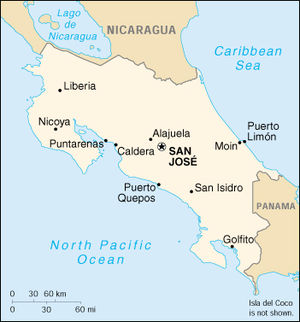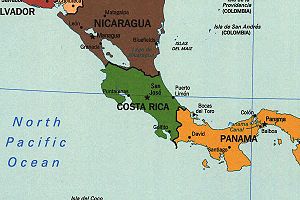Costa Rica
 From Conservapedia
From Conservapedia | República de Costa Rica | |
|---|---|
 | |
 |
 |
| Flag | Coat of Arms |
| Capital | San José |
| Government | Constitutional Republic |
| Language | Spanish (official) |
| President | Luis Guillermo Solís |
| Area | 19,725 sq mi |
| Population | 5,100,000 (2020) |
| GDP | $60,000,000,000 (2020) |
| GDP per capita | $11,765 (2020) |
| Currency | Costa Rican colón |
Costa Rica (officially the República de Costa Rica (Republic of Costa Rica)) is a Spanish-speaking country in Central America. The capital is San Jose. The country's name, literally 'Rich Coast', is claimed by locals to stem from its rich amount of biodiversity.
Costa Rica is also remarkable for having one of the highest standards of living in the region, including very low mortality rates. Part of its fame comes as a result of its demilitarised status - it was the first state in the world to abolish its national army by constitutional decree, in the New Constitution of 1949.
Contents
- 1 People
- 2 Government
- 2.1 Principal Government Officials
- 2.2 Political Conditions
- 2.3 Foreign Relations
- 3 Economy
- 4 History
- 5 References
People[edit]
Unlike many of their Central American neighbors, present-day Costa Ricans are largely of European rather than mestizo descent; Spain was the primary country of origin. However, an estimated 10% to 15% of the population is Nicaraguan, of fairly recent arrival and primarily of mestizo origin. Descendants of 19th century Jamaican immigrant workers constitute an English-speaking minority and—at 3% of the population—number about 119,000. Few of the native Indians survived European contact; the indigenous population today numbers about 29,000 or less than 1% of the population.
- Population (2007 est.): 4.13 million.
- Annual growth rate (2007 est.): 1.41%.
- Ethnic groups: European and some mestizo 94%, African origin 3%, Chinese 1%, Amerindian 1%, other 1%.
- Religion: Roman Catholic 76.3%, Evangelical 13.7%, Jehovah's Witnesses 1.3%, other Protestant 0.7%, other 4.8%, none 3.2%.
- Languages: Spanish, with a southwestern Caribbean Creole dialect of English spoken around the Limon area.
- Education: Years compulsory—9. Attendance—99% grades 1-6, 71% grades 7-9. Literacy—96%.
- Health: Infant mortality rate—9.45/1,000. Life expectancy—men 74.61 yrs., women 79.94 yrs.
- Work force (2006 est., 1.866 million; this official estimate excludes Nicaraguans living in Costa Rica legally and illegally): Agriculture—13%; industry—22%; services—64%.
Government[edit]

Costa Rica is a democratic republic with a very strong system of constitutional checks and balances. Executive responsibilities are vested in a president, who is the country's center of power. There also are two vice presidents and a 15-member cabinet. The president and 57 Legislative Assembly deputies are elected for 4-year terms. In April 2003, the Costa Rican Constitutional Court annulled a 1969 constitutional reform which had barred presidents from running for reelection. As a result, the law reverted to the 1949 Constitution, which permits ex-presidents to run for reelection after they have been out of office for two presidential terms, or eight years. Deputies may run for reelection after sitting out one term, or four years. In October 2007, the country held a national referendum on the U.S.-Central American-Dominican Republic Free Trade Agreement (CAFTA-DR).
The electoral process is supervised by an independent Supreme Electoral Tribunal—a commission of three principal magistrates and six alternates selected by the Supreme Court of Justice. Judicial power is exercised by the Supreme Court of Justice, composed of 22 magistrates selected for renewable 8-year terms by the Legislative Assembly, and subsidiary courts. A Constitutional Chamber of the Supreme Court (Sala IV), established in 1989, reviews the constitutionality of legislation and executive decrees and all habeas corpus warrants.
The offices of the Comptroller General of the Republic, the Solicitor General, and the Ombudsman exercise oversight of the government. The Comptroller General's office has a statutory responsibility to scrutinize all but the smallest public sector contracts and strictly enforces procedural requirements. With the Sala IV, these institutions are playing an increasingly prominent role in governing Costa Rica.
There are provincial boundaries for administrative purposes, but no elected provincial officials. Costa Rica held its first mayoral elections in December 2002, whereby mayors were elected to 4-year terms by popular vote through general elections. Prior to 2002, the office of mayor did not exist, and the president of each municipal council was responsible for the administration of his/her municipality. Autonomous state agencies enjoy considerable operational independence; they include the telecommunications and electrical power monopoly, the state petroleum refinery, the nationalized commercial banks, the state insurance monopoly, and the social security agency. Costa Rica has no military and maintains only domestic police and security forces. A professional Coast Guard was established in 2000.
Principal Government Officials[edit]
- President—Luis Guillermo Solís
- Foreign Minister—Bruno STAGNO Ugarte
- Ambassador to the United States—Tomás DUEÑAS
- Ambassador to the Organization of American States—Javier SANCHO Bonilla
- Ambassador to the United Nations—Jorge URBINA
Political Conditions[edit]
Costa Rica has long emphasized the development of democracy and respect for human rights. The country's political system has steadily developed, maintaining democratic institutions and an orderly, constitutional scheme for government succession. Several factors have contributed to this trend, including enlightened leadership, comparative prosperity, flexible class lines, educational opportunities that have created a stable middle class, and high social indicators. Also, because Costa Rica has no armed forces, it has avoided military involvement in political affairs, unlike other countries in the region.
In May 2006, President Oscar Arias of the National Liberation Party (PLN) assumed office, defeating principal rival Ottón Solis of the Civil Action Party by roughly 2% of the vote. Arias has listed passage of the CAFTA-DR, along with fiscal reform, infrastructure improvements, improving education, and improving security as primary goals for his presidency. The 57-member unicameral Legislative Assembly has four principal party factions, with the governing party, PLN, having a 25-seat plurality.
Foreign Relations[edit]

Costa Rica is an active member of the international community and, in 1993, proclaimed its permanent neutrality. Its record on the environment, human rights, and advocacy of peaceful settlement of disputes give it a weight in world affairs far beyond its size. The country lobbied aggressively for the establishment of the UN High Commissioner for Human Rights and became the first nation to recognize the jurisdiction of the Inter-American Human Rights Court, based in San Jose.
During the tumultuous 1980s, then President Oscar Arias authored a regional peace plan in 1987 that served as the basis for the Esquipulas Peace Agreement. Arias' efforts earned him the 1987 Nobel Peace Prize. Subsequent agreements, supported by the United States, led to the Nicaraguan election of 1990 and the end of civil war in Nicaragua. Costa Rica also hosted several rounds of negotiations between the Salvadoran Government and the Farabundo Marti National Liberation Front (FMLN), aiding El Salvador's efforts to emerge from civil war and culminating in that country's 1994 free and fair elections. Costa Rica has been a strong proponent of regional arms limitation agreements. President Arias has spoken out in public for self-determination in Cuba and expressed concern about eroding democratic institutions in Venezuela.
Economy[edit]
After four years of slow economic growth, the Costa Rican economy grew at nearly 5% in 2006. Compared with its Central American neighbors, Costa Rica has achieved a high standard of living, with a per capita income of about U.S. $5,100, and an unemployment rate of 6.6%. During 2006 the annual inflation rate dropped into the single digits (9.43%) for only the third time in the last 28 years; proof that the Costa Rican Government is seriously trying to reduce its large fiscal deficit.
Implementing CAFTA-DR, passing fiscal reform, and creating an effective concessions process are the biggest challenges for the country's economic policymakers. Costa Rica ranks 105th out of 175 countries in the World Bank's 2006 Doing Business Index. This hampers the flow of investment and resources badly needed to repair and rebuild the country's deteriorated public infrastructure.
Costa Rica's major economic resources are its fertile land and frequent rainfall, its well-educated population, and its location in the Central American isthmus, which provides easy access to North and South American markets and direct ocean access to the European and Asian Continents. One-fourth of Costa Rica's land is dedicated to national forests, often adjoining picturesque beaches, which has made the country a popular destination for affluent retirees and eco-tourists.
Costa Rica used to be known principally as a producer of bananas and coffee, but pineapples have surpassed coffee as the number two agricultural export. In recent years, Costa Rica has successfully attracted important investments by such companies as Intel Corporation, which employs nearly 2,000 people at its $300 million microprocessor plant; Procter & Gamble, which employs nearly 1,000 people in its administrative center for the Western Hemisphere; and Hospira and Baxter Healthcare from the health care products industry. Manufacturing and industry's contribution to GDP overtook agriculture over the course of the 1990s, led by foreign investment in Costa Rica's free trade zone. Well over half of that investment has come from the United States. Dole and Chiquita have a large presence in the banana and pineapple industries. Two-way trade between the U.S. and Costa Rica exceeded $7.9 billion in 2006.
- GDP (2006): $20.77 billion.
- GDP PPP (2006 est.): $48.77 billion.
- Inflation (2006 est.): 9.43%.
- Real growth rate (2006 est.): 4.7%.
- Per capita income (2006): $5,100. (PPP $12,000, 2006 est.)
- Unemployment (2006 est.): 6.6%.
- Currency: Costa Rica Colon (CRC).
- Natural resources: Hydroelectric power, forest products, fisheries products.
- Agriculture (8.6% of GDP): Products—bananas, pineapples, coffee, beef, sugar, rice, dairy products, vegetables, fruits and ornamental plants.
- Industry (31% of GDP): Types—electronic components, food processing, textiles and apparel, construction materials, fertilizer, medical equipment.
- Commerce, tourism, and services (60.4% of GDP): Hotels, restaurants, tourist services, banks, and insurance.
- Trade (2006 est.): Exports--$7.931 billion: bananas, pineapples, coffee, melons, ornamental plants, sugar, textiles, electronic components, medical equipment. Major markets—U.S. 42.6%, Hong Kong 6.9%, Netherlands 6.4%, Guatemala 4.2%. Imports--$10.88 billion: raw materials, consumer goods, capital equipment, petroleum. Major suppliers—U.S. 41.3%, Japan 5.6%, Venezuela 4.8%, Mexico 4.8%, Ireland 4.3%, Brazil 4.2%, China 4.2%.
Costa Rica has oil deposits off its Atlantic Coast, but the Pacheco administration (2002-2006) decided not to develop the deposits for environmental reasons. The country's mountainous terrain and abundant rainfall have permitted the construction of a dozen hydroelectric power plants, making it largely self-sufficient in electricity, but it is completely reliant on imports for liquid fuels. Costa Rica has the potential to become a major electricity exporter if plans for new generating plants and a regional distribution grid are realized. Mild climate and trade winds make neither heating nor cooling necessary, particularly in the highland cities and towns where some 90% of the population lives.
Costa Rica's public infrastructure has suffered from a lack of maintenance and new investment. The country has an extensive road system of more than 30,000 kilometers, although much of it is in disrepair. Most parts of the country are accessible by road.
Costa Rica has sought to widen its economic and trade ties within and outside the region. Costa Rica signed a bilateral trade agreement with Mexico in 1994, which was later amended to cover a wider range of products. Costa Rica joined other Central American countries, plus the Dominican Republic, in establishing a Trade and Investment Council with the United States in March 1998. Costa Rica has signed trade agreements with Canada, Chile, the Dominican Republic, Mexico, and Trinidad and Tobago. It is negotiating a trade agreement with Panama and is poised to begin negotiating a regional Central American-EU trade agreement in 2007. Costa Rica was an active participant in the negotiation of the hemispheric Free Trade Area of the Americas and is active in the Cairns Group, which is pursuing global agricultural trade liberalization within the World Trade Organization.
Costa Rica concluded negotiations with the U.S. to participate in CAFTA-DR in January 2004. The Legislative Assembly began debate in October 2005, but Costa Rica is the only CAFTA-DR partner not to have yet entered the agreement into force. Ratification and implementation are pending final results of the October 2007 referendum. Once implemented, CAFTA would bring about the partial opening of the state telecommunications monopoly and a substantial opening of the state-run insurance sector.
History[edit]

In 1502, on his fourth and last voyage to the New World, Christopher Columbus made the first European landfall in the area. Settlement of Costa Rica began in 1522. For nearly three centuries, Spain administered the region as part of the Captaincy General of Guatemala under a military governor. The Spanish optimistically called the country "Rich Coast." Finding little gold or other valuable minerals in Costa Rica, however, the Spanish turned to agriculture.
The small landowners' relative poverty, the lack of a large indigenous labor force, the population's ethnic and linguistic homogeneity, and Costa Rica's isolation from the Spanish colonial centers in Mexico and the Andes all contributed to the development of an autonomous and individualistic agrarian society. An egalitarian tradition also arose. This tradition survived the widened class distinctions brought on by the 19th century introduction of banana and coffee cultivation and consequent accumulations of local wealth.
Costa Rica joined other Central American provinces in 1821 in a joint declaration of independence from Spain. Although the newly independent provinces formed a Federation, border disputes broke out among them, adding to the region's turbulent history and conditions. Costa Rica's northern Guanacaste Province was annexed from Nicaragua in one such regional dispute. In 1838, long after the Central American Federation ceased to function in practice, Costa Rica formally withdrew and proclaimed itself sovereign.
An era of peaceful democracy in Costa Rica began in 1899 with elections considered the first truly free and honest ones in the country's history. This began a trend continued until today with only two lapses: in 1917-19, Federico Tinoco ruled as a dictator, and, in 1948, Jose Figueres led an armed uprising in the wake of a disputed presidential election.
With more than 2,000 dead, the 44-day civil war resulting from this uprising was the bloodiest event in 20th century Costa Rican history, but the victorious junta drafted a constitution guaranteeing free elections with universal suffrage and the abolition of the military. Figueres became a national hero, winning the first election under the new constitution in 1953. Since then, Costa Rica has held 14 presidential elections, the latest in 2006.
References[edit]
| Copyright Details | |
|---|---|
| License: | This work is in the Public Domain in the United States because it is a work of the United States Federal Government under the terms of Title 17, Chapter 1, Section 105 of the U.S. Code |
| Source: | File available from the United States Federal Government. |
Categories: [Costa Rica] [Central American Countries] [Christian-Majority Countries]
↧ Download as ZWI file | Last modified: 02/28/2023 02:08:15 | 80 views
☰ Source: https://www.conservapedia.com/Costa_Rica | License: CC BY-SA 3.0
 ZWI signed:
ZWI signed: KSF
KSF